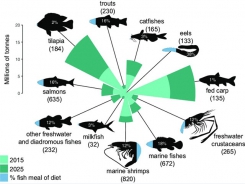Tackling sea lice in the face of climate change

The offspring of salmon that have been bred to be more resistant to sea lice may not be so resistant in warmer waters, according to new research by Nofima.
The genetic analysis revealed that neither growth nor the lice load are single traits, but vary with water temperature. The scientists also suspect that some of the compounds in salmon mucous attract lice. Photo: Terje Aamodt, Nofima
“With climate change and more frequent heatwaves in the ocean I think this is useful information for breeding companies,” says Nofima scientist Celeste Jacq.
The individual characteristics of both salmon and sea lice can determine whether the sea lice attach to, and feed on, a salmon. The fact that resistance to sea lice is hereditary in salmon is known, but the FutureFish project is now looking to increase robustness in salmon and lumpfish in the face of climate change.
Growth and lice activity are temperature dependent
The first trials in the project were conducted in the winter of 2017, when 50 salmon families from Mowi were distributed across different tanks at the Aquaculture Research Station in Tromsø. At the start of the trial the salmon weighed 100 grams, and were reared in seawater of 5, 10 and 17°C. A few weeks into the experiment, the researchers added juvenile sea lice to the tanks and measured the effect on the salmon. They counted the number of sea lice, took samples of mucous and skin and measured the size of the fish. They analysed the DNA for 45,000 genetic markers and examined the relationship between the lice load and salmon growth at the different temperatures.
The genetic analysis revealed that neither growth nor the lice load are single traits, but vary with water temperature. There is only a weak to moderate genetic correlation between salmon growth in seawater at 5°C and 17°C.
“The good news is that it is possible to breed for reduced temperature sensitivity to ensure increased salmon growth and resistance to sea lice even in fluctuating temperatures,” says Jacq.
The project had several interesting results that indicate why different salmon characteristics are associated with sea lice resistance at both high and low temperatures.
The salmon's smell and lice infestation are linked
Nofima scientists John-Erik Haugen and Gareth Difford combined their respective knowledge about aroma compounds and genetics and found some volatile organic compounds in the mucous on the salmon skin that seem to attract sea lice.
“We also found that the salmon families that are resistant to lice produce less of these compounds, and vice versa,” says Difford.
The scientists now plan to investigate this further by using species-independent variation to improve sea lice resistance, in a new project funded by the Norwegian Seafood Research Fund.
The fish health researchers also found structural differences in the skin of the salmon. The outermost barrier of the skin, the epidermis, was thinner in fish that had been reared at 17°C and had markedly smaller mucous cells. The combined results may indicate that the fish skin barrier weakens over time when the fish lives in warmer water. In addition, the researchers found chemical differences in the mucous between fish from high and low temperature tanks. How these mucosal properties impact fish health will be investigated further.
Breeding lumpfish to eat more lice
Finally, the scientists used genomic information to examine the heritability of sea lice eating ability in lumpfish. The heritability for this trait was low, but there were significant differences between families. This means that it is possible to use genetic selection to increase lice eating ability through breeding programmes, which can reduce the reliance on wild-caught cleaner fish and chemical delousing agents.
Related news
Tools

Phối trộn thức ăn chăn nuôi

Pha dung dịch thủy canh

Định mức cho tôm ăn

Phối trộn phân bón NPK

Xác định tỷ lệ tôm sống

Chuyển đổi đơn vị phân bón

Xác định công suất sục khí

Chuyển đổi đơn vị tôm

Tính diện tích nhà kính

Tính thể tích ao



 How breeding can improve lice-eating efficacy of lumpfish…
How breeding can improve lice-eating efficacy of lumpfish…  How enzymes can improve aquafeed utilisation
How enzymes can improve aquafeed utilisation